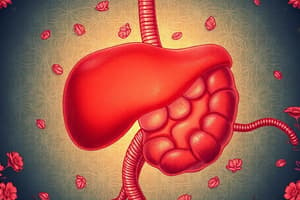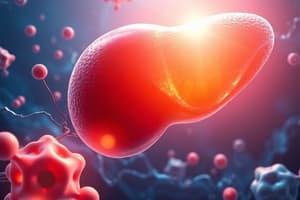Podcast
Questions and Answers
Which component is primarily found in the core of a lipoprotein?
Which component is primarily found in the core of a lipoprotein?
- Phospholipids
- Free cholesterol
- Triglycerides and cholesterol esters (correct)
- Apolipoproteins
HDL is considered 'bad cholesterol' due to its role in plaque formation in arteries.
HDL is considered 'bad cholesterol' due to its role in plaque formation in arteries.
False (B)
What is the main function of VLDL?
What is the main function of VLDL?
Transport triglycerides synthesized by the liver to peripheral tissues.
The largest and least dense type of lipoprotein is the ______
The largest and least dense type of lipoprotein is the ______
Match the lipoproteins with their primary function:
Match the lipoproteins with their primary function:
Which of the following molecules are found in the shell of a lipoprotein?
Which of the following molecules are found in the shell of a lipoprotein?
Chylomicrons primarily transport cholesterol from the liver to peripheral tissues.
Chylomicrons primarily transport cholesterol from the liver to peripheral tissues.
LDL is often referred to as 'bad cholesterol' because it contributes to the development of ______.
LDL is often referred to as 'bad cholesterol' because it contributes to the development of ______.
Match the following lipoproteins with their respective characteristics:
Match the following lipoproteins with their respective characteristics:
What determines the classification of lipoproteins?
What determines the classification of lipoproteins?
Apolipoproteins are found in the core of lipoproteins.
Apolipoproteins are found in the core of lipoproteins.
What is the primary role of HDL in cholesterol transport?
What is the primary role of HDL in cholesterol transport?
_______ are lipoproteins formed in the intestine to transport dietary lipids.
_______ are lipoproteins formed in the intestine to transport dietary lipids.
Match the following lipoproteins with their primary function:
Match the following lipoproteins with their primary function:
Which lipoprotein is considered the precursor to LDL after triglycerides are removed?
Which lipoprotein is considered the precursor to LDL after triglycerides are removed?
High-density lipoproteins (HDL) transport triglycerides from the liver to peripheral tissues.
High-density lipoproteins (HDL) transport triglycerides from the liver to peripheral tissues.
What is the primary function of apolipoproteins in lipoproteins?
What is the primary function of apolipoproteins in lipoproteins?
The 'good cholesterol' is also known as ________ due to its role in preventing plaque buildup in arteries.
The 'good cholesterol' is also known as ________ due to its role in preventing plaque buildup in arteries.
Flashcards
What determines lipoprotein classification?
What determines lipoprotein classification?
Lipoproteins are classified based on their density, which is determined by the ratio of lipids to proteins.
What is the role of chylomicrons?
What is the role of chylomicrons?
Chylomicrons are the largest and least dense lipoproteins, primarily responsible for transporting dietary fats from the intestines to tissues.
What are VLDLs and what do they do?
What are VLDLs and what do they do?
VLDLs are triglyceride-rich lipoproteins that transport fats synthesized by the liver to various tissues. They are the precursors to LDLs after triglycerides are removed.
What is LDL's role and why is it called 'bad cholesterol'?
What is LDL's role and why is it called 'bad cholesterol'?
Signup and view all the flashcards
What makes HDL 'good cholesterol'?
What makes HDL 'good cholesterol'?
Signup and view all the flashcards
Study Notes
Lipoprotein Structure
- Lipoproteins are composed of a hydrophobic core and an amphipathic shell.
- Core: Hydrophobic lipids (triglycerides and cholesterol esters).
- Shell: Amphipathic molecules (phospholipids, free cholesterol, and proteins – apolipoproteins).
Types of Lipoproteins
- Lipoproteins are categorized by density, which reflects the lipid-to-protein ratio.
Chylomicrons
- Function: Transport dietary triglycerides and cholesterol from the intestine to tissues.
- Properties: Largest and least dense, triglyceride-rich.
Very Low-Density Lipoproteins (VLDL)
- Function: Transport liver-synthesized triglycerides to peripheral tissues.
- Apolipoproteins: ApoB-100, ApoC-II, ApoE.
- Properties: Triglyceride-rich; precursor to LDL after triglyceride removal.
Low-Density Lipoproteins (LDL)
- Function: Deliver cholesterol to peripheral tissues.
- Properties: Known as "bad cholesterol"; excess LDL contributes to atherosclerosis (plaque buildup in arteries).
High-Density Lipoproteins (HDL)
- Function: Collect excess cholesterol from tissues and return it to the liver (reverse cholesterol transport).
- Properties: Known as "good cholesterol"; protective against atherosclerosis.
Studying That Suits You
Use AI to generate personalized quizzes and flashcards to suit your learning preferences.




